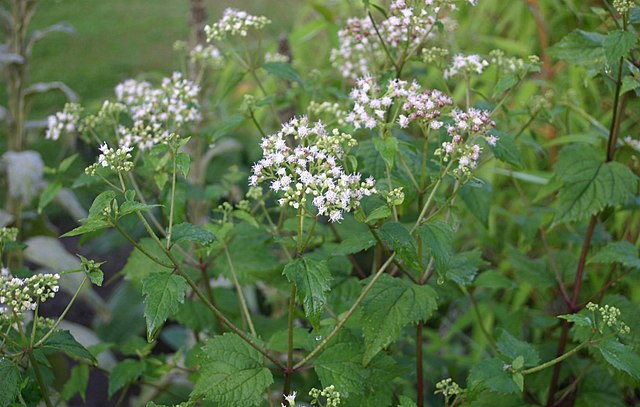White Snakeroot (Ageratina altissima) is a herbaceous perennial plant native to North America. It is known for its clusters of small, white flowers and serrated leaves. While it has some ornamental value, it’s important to note that White Snakeroot contains a toxin that can be harmful to livestock and, indirectly, to humans who consume contaminated products. Here’s an ultimate guide to White Snakeroot:
1. Botanical Features:
- Appearance: White Snakeroot typically grows 3 to 5 feet tall and produces small, fluffy, white flowers in clusters.
- Leaves: The leaves are toothed, opposite, and have a rough texture. They are arranged in pairs along the stem.

2. Growing Conditions:
- Habitat: White Snakeroot is commonly found in woodlands, meadows, and along streams in its native range.
- Soil: It prefers well-drained soil and can tolerate various soil types.
3. Toxicity:
- Causative Toxin: The plant contains a toxin called tremetol.
- Livestock Poisoning: Ingesting White Snakeroot can lead to a condition known as “milk sickness” in livestock, and humans can be indirectly affected by consuming the milk or meat of poisoned animals.
4. Historical Significance:
- Abraham Lincoln’s Mother: Nancy Hanks Lincoln, the mother of Abraham Lincoln, is believed to have died from milk sickness, which was later attributed to the consumption of milk or meat from cows that had grazed on White Snakeroot.
5. Cultural Uses:
- Medicinal Uses: Historically, some Native American tribes used White Snakeroot for medicinal purposes, although its use is not recommended due to its toxicity.
- Ethnobotanical Significance: The plant has ethnobotanical significance in traditional practices.
6. Ornamental Value:
- Wildflower Gardens: Some gardeners appreciate the plant for its wildflower appearance and use it in naturalized or woodland gardens.
- Wildlife Attraction: The flowers attract pollinators, including bees and butterflies.
7. Control and Management:
- Preventing Ingestion: For areas with livestock, it’s crucial to prevent access to White Snakeroot to avoid poisoning.
- Herbicide Control: In situations where control is necessary, herbicides can be used, but caution is advised due to the potential impact on surrounding plants and the environment.
8. Landscaping Considerations:
- Caution in Livestock Areas: If you have livestock, especially cows, it’s advisable to be cautious about planting White Snakeroot in areas where they graze.
- Alternative Plants: Consider using non-toxic plants with similar aesthetics in landscaping.
9. Wildlife Habitat:
- Ecological Role: While White Snakeroot can be harmful in certain contexts, it also plays a role in supporting local ecosystems by providing habitat and food for some wildlife.
10. Education and Awareness:
- Public Awareness: It’s important to educate the public, especially those in rural areas with livestock, about the dangers of White Snakeroot and the importance of preventing ingestion by animals.
11. Observation:
- Identification: Learn to identify White Snakeroot to avoid accidental ingestion by animals or humans.
- Reporting: If you suspect cases of livestock poisoning due to White Snakeroot, report it to relevant authorities.
In conclusion, while White Snakeroot has some ornamental value, its toxicity makes it a plant that should be approached with caution, especially in areas where livestock graze. Awareness, proper identification, and preventive measures are essential for managing its presence in both natural and cultivated settings.











